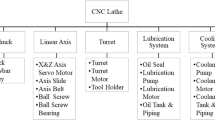Abstract
Criticality analysis is a technique for the assessment of criticality rating for every constitutive part. Failure mode effect and criticality analysis (FMECA) are broadly utilized for characterizing, distinguishing and dispensing with potential failures from system, design, or process for the criticality analysis. The determination of the critical ranking of failure modes for criticality analysis is a vital issue of FMECA. The traditional method of FMECA determines the critical ranking of failure modes using the risk priority numbers, which is the product of evaluation criteria like the occurrence, severity and detection of each failure mode but it may not be realistic in some applications. The practical applications reveal that the criticality analysis using traditional FMECA has been considerably criticized for several reasons. In this paper, first, a detailed FMEA to find out the various failure modes of each component of a conventional lathe machine is performed and thereafter, the Fuzzy FMECA approach is used to perform the criticality analysis. A comparative analysis of fuzzy FMECA with traditional FMECA is also done to find out the most superior approach for the criticality analysis. It was concluded that the fuzzy FMECA approach is the most superior approach for the criticality analysis of a system.



Similar content being viewed by others
References
Ben-daya M, Raouf A (1996) A revised failure mode and effects analysis model. Int J Quality Reliab Manag 13:43–47
Bertolini M (2006) Fuzzy VIKOR criticality analysis approach for FMECA technique. Saf Reliab Manag Risk 1:101–108
Bowles JB (2003) An assessment of RPN prioritization in a failure modes effects and criticality analysis. In: Annual reliability and maintainability symposium, pp 380–386
Bowles JB, Peldez CE (1995) Fuzzy logic prioritization of failures in a system failure mode, effects and criticality analysis. Reliab Eng Syst Saf 50:203–213
Braglia M, Frosolini M, Montanari R (2003a) Fuzzy TOPSIS approach for failure mode, effects and criticality analysis. Quality Reliab Eng Int 19:425–443
Braglia M, Frosolini M, Montanari R (2003b) Fuzzy criticality assessment model for failure modes and effects analysis. Int J Quality Reliab Manag 20:503–524
Carmignani G (2009) An integrated structural framework to cost-based FMECA: the priority-cost FMECA. Reliab Eng Syst Saf 94:861–871
Catic D, Jeremic B, Djordjevic Z, Miloradovic N (2011) Criticality analysis of the elements of the light commercial vehicle steering tie-rod joint. J Mech Eng 57:495–502
Chang CL, Wei CC, Lee YH (1999) Failure mode and effects analysis using fuzzy method and grey theory. Kybernetes 28:1072–1080
Chang CL, Liu PH, Wei CC (2001) Failure mode and effects analysis using grey theory. Integr Manuf Syst 12:211–216
Gargama H, Chaturvedi SK (2011) Criticality assessment models for failure mode effects and criticality analysis using fuzzy logic. IEEE Trans Reliab 60:102–110
Gilchrist W (1996) Modelling failure modes and effects analysis. Int J Quality Reliab Manag 10:43–47
Juran JM (1989) Quality control handbook. McGraw-Hill, New York
Pillay A, Wang J (2003) Modified failure mode and effects analysis using approximate reasoning. Reliab Eng Syst Saf 79:69–85
Popovic V, Vasic B, Petrovic M (2010) The possibility for FMEA method improvement and its implementation into bus life cycle. J Mech Eng 56:179–185
Sankar NR, Prabhu BS (2001) Modified approach for prioritization of failures in a system failure mode and effects analysis. Int J Quality Reliab Manag 18:324–335
Sharma RK, Kumar D, Kumar P (2005) Systematic failure mode effect analysis (FMEA) using fuzzy linguistic modelling. Int J Quality Reliab Manag 22:986–1004
Sharma KR, Kumar D, Kumar P (2006) Systematic failure mode effect analysis (FMEA) using fuzzy linguistic modelling. Int J Quality Reliab Manag 22:986–1004
Stamatis DH (1995) Failure mode and effect analysis: FMEA. In: Theory to execution. ASQC Quality Press, Milwaukee, WI
Teng SH, Ho SY (1996) Failure mode and effects analysis: an integrated approach for product design and process control. Int J Quality Reliab Manag 13:8–26
Wang Y, Chin K, Poon G, Ka K, Yang J (2009) Risk evaluation in failure mode and effects analysis using fuzzy weighted geometric mean. Expert Syst Appl 36:1195–1207
Xu K, Tang L, Xie M, Ho S, Zhu M (2002) Fuzzy assessment of FMEA for engine systems. Reliab Eng Syst Saf 75:17–29
Yang ZY, Xu BX, Chen F, Hao Q, Zhu X, Jia Y (2010) A new failure mode and effects analysis model of CNC machine tool using fuzzy theory. In: IEEE international conference on information and automation June 20–23, Harbin, China, pp 582–587
Author information
Authors and Affiliations
Corresponding author
Additional information
Publisher's Note
Springer Nature remains neutral with regard to jurisdictional claims in published maps and institutional affiliations.
Rights and permissions
About this article
Cite this article
Gupta, G., Mishra, R.P. Comparative analysis of traditional and fuzzy FMECA approach for criticality analysis of conventional lathe machine. Int J Syst Assur Eng Manag 11 (Suppl 2), 379–386 (2020). https://doi.org/10.1007/s13198-019-00938-y
Received:
Revised:
Published:
Issue Date:
DOI: https://doi.org/10.1007/s13198-019-00938-y




